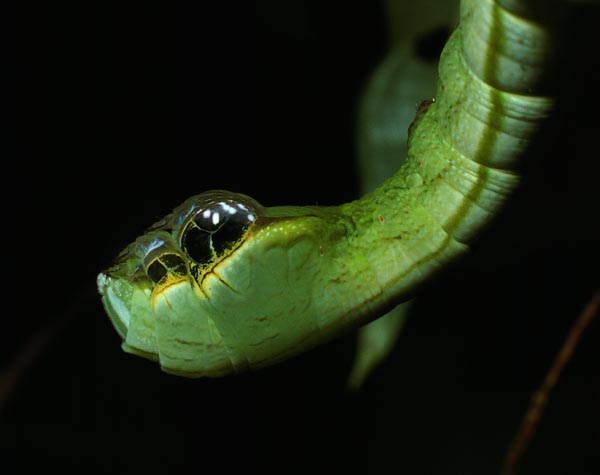Hemeroplanes sp. (Sphingidae)
This genus has some of the most well-known examples of snake-mimicry by caterpillars. I'm not sure that all species in the genus have this defence, but the ones that do only seem have to gain the mimetic phenotype it in the late instars when the caterpillar is large.Here are some photos of Hemeroplanes triptolemus from Dan Janzen's caterpillar database:
Green morph
Brown morph
Note that the back of the caterpillar (pictured above) is a motled grey-brown, and the caterpillar is probably very cryptic on a tree trunk or branch.
I was fortunate enough to see a Hemeroplanes sp. caterpillar when I travelled to Peru (2007) during my undergraduate degree. Below is the brutal sketch and notes that I made upon seeing this specimen in the forest (*not an artist*). In my defence it had to be quick because we were a reasonably big group and on the move. Importantly I did capture key details about the morphology, colour, and behaviour.
Here is a video I took of the caterpillar that we came across to give you a sense of its attitude when harassed (sorry for the poor quality):
Side note: "It's a caterpillar", yea, that is me... You can't hear it but I was replying to another student who didn't know much about insects and asked what it was.
The caterpillar does a great job of mimicking a snake behaviourally as well. It is actually throwing itself backwards and twisting to reveal its underside which is hidden when the caterpillar is at rest. The anterior (head-end) body segments of the caterpillar inflate to form a diamond-shaped head, when fully inflated the “eyes” of the snake-like false head seem to open.
Here is another video of this caterpillar I found on YouTube: http://youtu.be/fgYObIslq98
*Update: Here is another GREAT video of this mimicry in action: http://youtu.be/DxEDmXTASpg
Definitely feel a bit bad for that little guy, but it looks uninjured and was reportedly replaced on its hostplant after the video. It is hard to doubt that this one is mimicking a snake. For some reason many people seem to think that the true head and the false-head are at opposite ends of the caterpillar. This is not the case. The caterpillar’s true head is small in proportion to this inflated region, but if you look closely you can see that the caterpillar’s head is at the “nose-end” of the false head. You can see that this is the case particularly well in the YouTube video and photos above. I remember when we encountered the Hemeroplanes sp. caterpillar in Peru the Professor leading the trip refused to believe me that the true head was at the end of the false head (he was a great Ornithologist though so maybe we can forgive him).
I suspect the reason why people make this mistake is because eyespots and false heads frequently occur on tails, or less-vital regions of an animal’s body. In these cases the strategy is to bait the predator’s strike away from the prey-animal’s true head or vital body parts. Biologists call this strategy deflection. Deflection might not work well for a caterpillar though because the caterpillar probably won’t survive if any part of its body gets pierced or ripped off by an attacker. Really this defence is probably all about intimidating or startling an attacker who will run (or fly...) away instead of risk a lethal encounter with a snake. For most predators (e.g., insect-eating birds) the world is full of enemies and snakes in particular are very dangerous. When confronted with the possible threat of death by a snake (or other predator) the attacker will just flee because it isn’t worth the morsel of food the caterpillar represents.
I came across a great set of photos on imgur. This is a Hemeroplanes sp. and in the link below there is a great sequence showing the eyespots opening and closing. As always with imgur, check out the comments for a laugh: http://imgur.com/gallery/gGALI
Another site with some great pictures and descriptions of the Hemeroplanes sp. caterpillar here: http://www.thenighttour.com/alien2/hemeroplanes.htm












Wow! Extremely interesting and detailed info on this marvelous creature! Thank you for this!!!
ReplyDeleteWow. I had not seen this before. Thank you for sharing!
ReplyDeleteWhat are any important population interactions relevant to the mimicry or survival of the species?
ReplyDelete